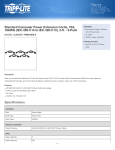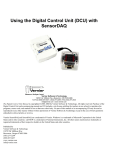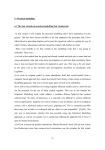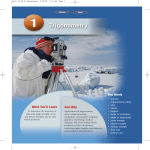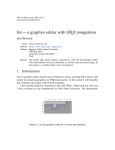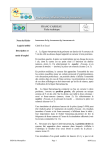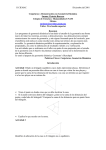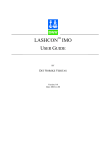Download Geometric and algebraic modelling with dynamic
Transcript
Geometric and algebraic modelling with dynamic geometry software Figure 1 The Geometer’s Sketchpad V.4 and Cabri Geometry II plus With an image on the clipboard, use Edit and Paste Picture to place the image on the current drawing. Here, in Figure 2, I have pasted it twice in different places to show how Sketchpad always treats this as `transparent images’ so that construction lines are not obscured by the image. We will try to model the trajectory of the water spout using a quadratic function of the form: y = ax 2. Using the Graph menu we can define a New Parameter – here called a 1 and then use Plot New Function to define and plot a function entered algebraically. A particularly interesting form of modelling became available in Sketchpad V.2 by being able to import a picture via the Windows clipboard and to superimpose constructions, axes and graphs on it. This was not, to my knowledge, possible in Cabri 2. The segment AC is drawn to define the direction of the x-axis. The function is entered as ‘a 1*x^2’. Sketchpad gives it the label ‘f(x)’ and tidies up the algebraic notation, as well as plotting the graph of the function against our current axes. When Sketchpad V.4 appeared it made algebraic functions directly definable and plottable, thus combining the features of dynamic geometry software with those of a familiar graph-plotting package. In particular we could now model captured images either geometrically or algebraically or both. A point O is chosen on one of the images so as the origin for coordinates, and lines drawn through O, parallel and perpendicular to AC. Adrian Oldknow The flood gates opened for modelling with dynamic geometry software (DGS) when both Cabri II and Sketchpad V.2 allowed you to perform calculations on measurements and to use such results to plot the coordinates of a point on specified axes. Using a subset of the x-axis as the domain for a free (draggable) point P allowed you perform calculations on its x-coordinate to obtain a corresponding y-coordinate from some function defined by the calculation. The resulting point Q (x,y) would then trace a curve as P was dragged on its domain – and that point could be selected to leave a trace. Alternatively, the locus of Q as a function of P could be drawn – the locus being the graph of the function of x – which never appeared explicitly in symbolic form in the process. 16 Figure 2 I now illustrate an approach to algebraic modelling applied to a digital photograph of the fountain in Singapore harbour using Sketchpad V. 4 (see Fig 1). A point B on it is used as a `slider’ so that AB defines the unit distance for both axes. The circle centre O, radius AB, is drawn (not shown) and used to define the unit circle for a new set of axes. The intersections of the circle with the positive axes are shown as Px and Py. The unit circle and the horizontal and vertical lines are now hidden leaving only the axes. By highlighting the parameter you can use the `+’ and ‘-‘ keys to increase or decrease its value. I have also constructed a subset of the x-axis as the domain of the sliding point P and illustrated the “old” technique to obtain the dependent point Q which can now be seen to trace the curve. If we knew that a quadratic curve was also a parabola with a `focus-directrix’ definition, we could have imposed a geometric model by chosing some point F on the negative y-axis as focus and drawn the directrix as the line parallel to the x-axis through 17 Figure 3 the reflection of F in the x-axis (see Figure 3). If R is any point on the directrix, we seek to construct the point S on the perpendicular to the directrix at R which is such that FS = SR. This means that triangle FSR is isosceles and hence the vertex S is the point where the perpendicular bisector of the base FR meets the perpendicular to the directrix through R. The locus of S with R is the geometric parabola, and we can slide the focus F to discover when it best agrees with both the water spout and the algebraic (quadratic) model. When Cabri Geometry II plus came out early this year I was delighted to receive an early copy. Certain features had immediate appeal, such as the larger icons and menus which are more friendly for whole class work, such as with an interactive whiteboard. The major drawback is that the little User Manual does not give much information about the new features. One of these is the introduction of the Expression option which allows you enter a function of x using the same notations as you would use with built-in 18 Calculator. I haven’t found a way of introducing a variable parameter into such a function, but it is easily editable to change any part of the equation. To evaluate it, using the Evaluate an Expression command, you must also specify a value to substitute for x. So in the model at the top of the next page (see Figure 4), I have started in exactly the same way as with Sketchpad – but the trick was to discover how to import a picture! You do this by rightclicking the mouse anywhere on the background and selecting Background Image, and the From File – which allows you to import an image file such as JPEG. You can also define a point with the Point tool and right-click on it to import an image which is draggable around the screen. Just as before, the axes have been defined relative to the origin O and unit points X,Y defined by the slider B on AC. Now you need to define a variable point Px on the x-axis and Measure its coordinates (which I’ve labelled as Px) so that you have a value Figure 4 of x to substitute into the function definition (labelled here as f(x)), which returns a value which I’ve labelled as Py. Use the Measurement Transfer command to transfer this to the y-axis. Then construct perpendiculars to the axes at Px and Py to define their intersection as the point P. The locus of P with Px is then the graph of the algebraic function f(x). Dragging Px shows that P traces the graph. Editing the function immediately changes the shape of the graph. In Figure 4, the screen shot from Cabri Geometry II plus, I have also shown the geometric construction for the parabola. So the moral of this little tale is that both the most recent version of the two most widely used dynamic geometry software packages allow you to perform both geometric and algebraic modelling using captured images. Perhaps Sketchpad has a slight edge with its Plot As (x,y) and New Parameter functions, but maybe Cabri has something up its sleeve too – my final Sketchpad file for the model weighs in at 3834 Kb against Cabri’s 319 Kb. Postscript: some people are very attached to using the Numerical Edit feature of Cabri to enter an initial value or parameter which can be easily incremented, decremented or animated. The New Parameter function of Sketchpad V. 4 allows just the same strategy to be used – but with the added advantage that units such as centimetres and degrees can also be attached. Adrian Oldkno w t. Acknowledgement Philip Yorke of Chartwell Yorke for providing the review copy of Cabri Geometry II plus . 19


